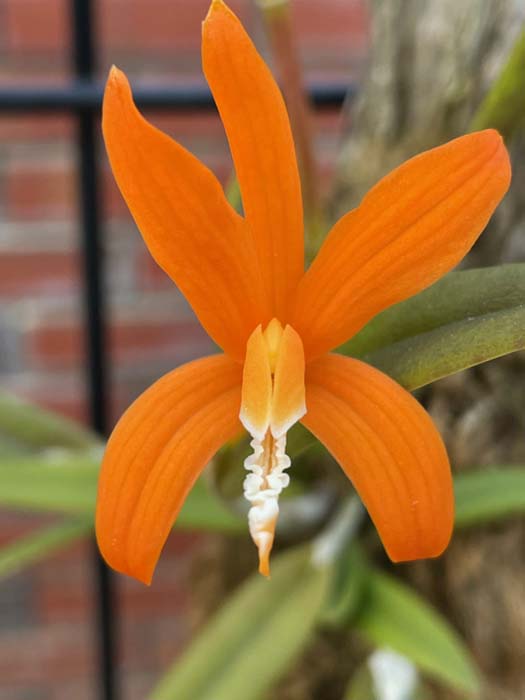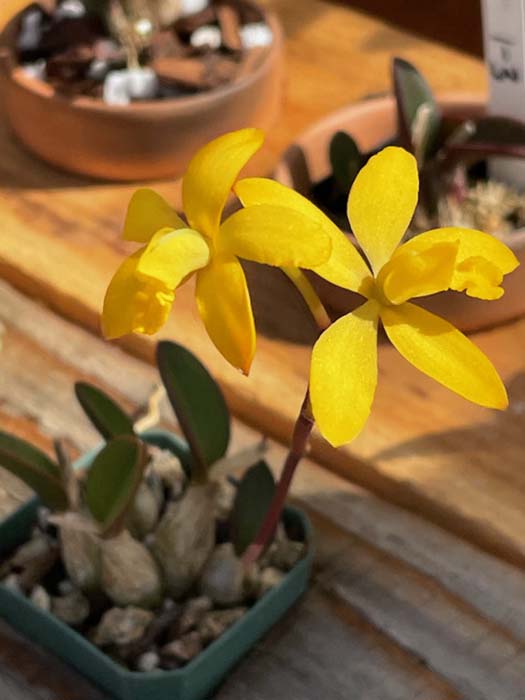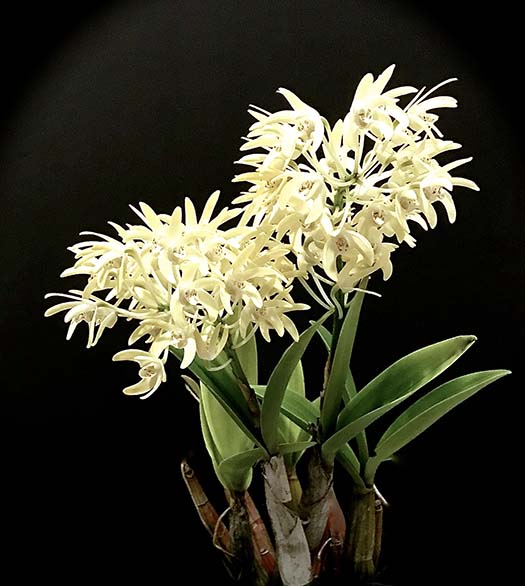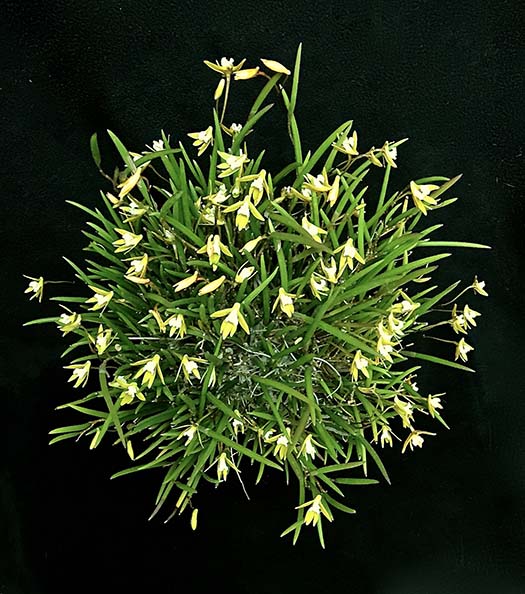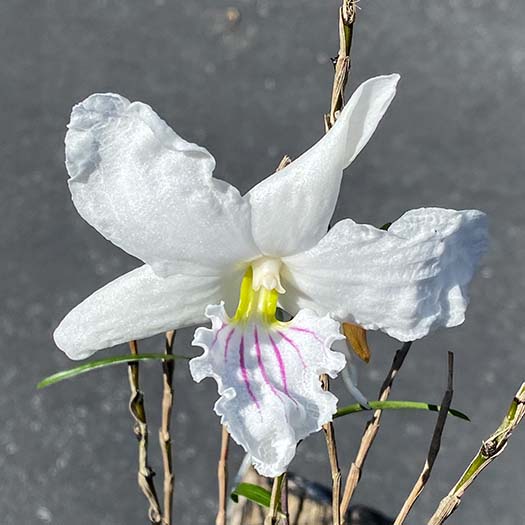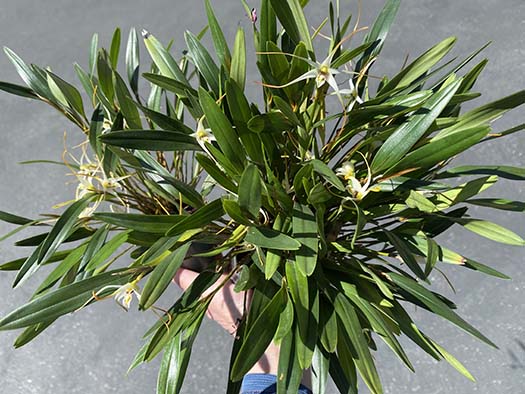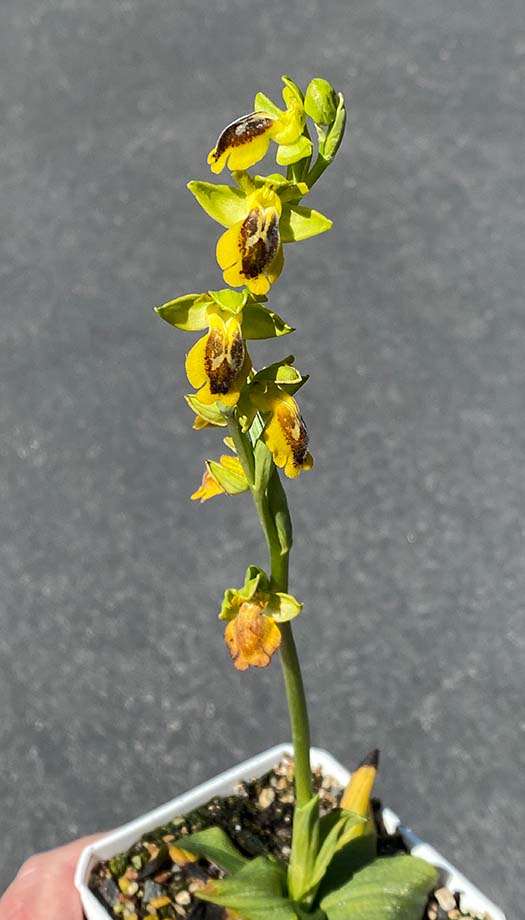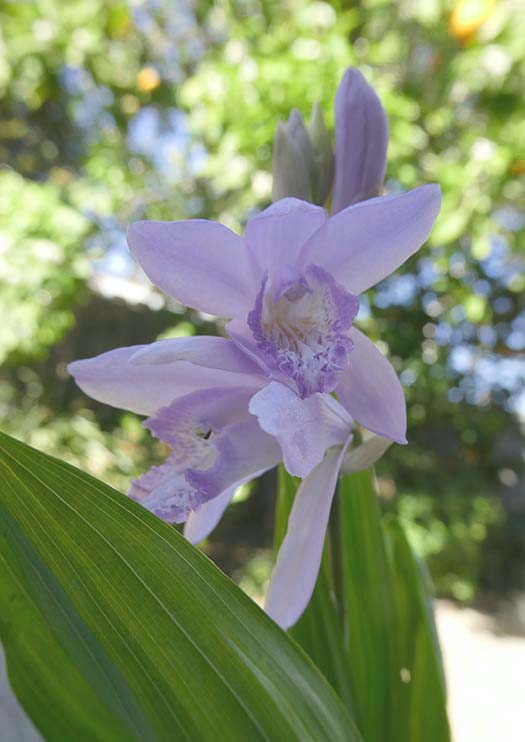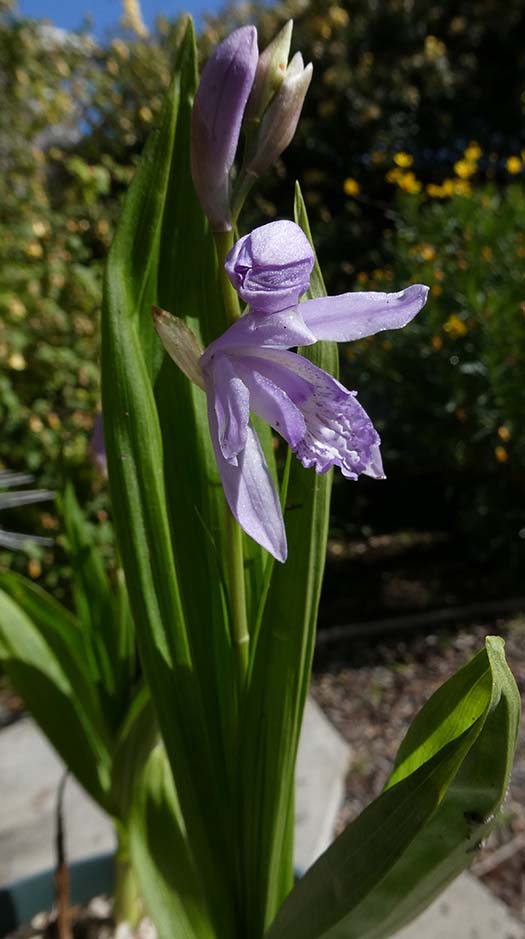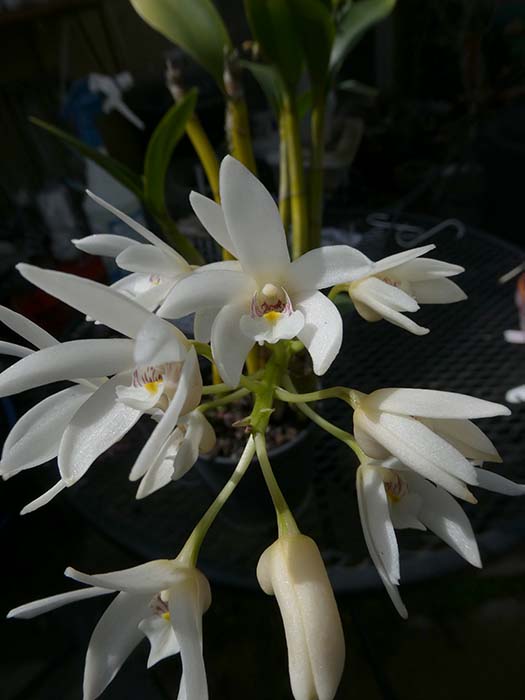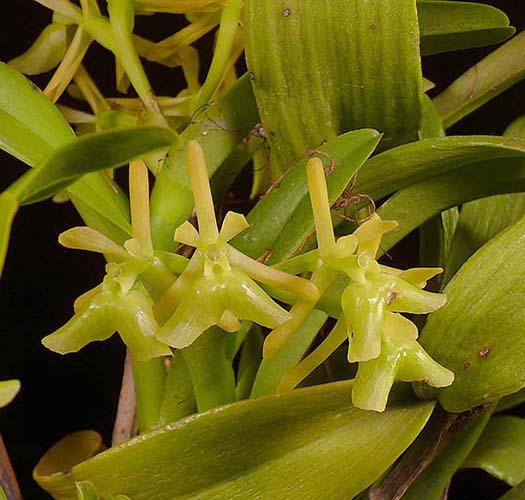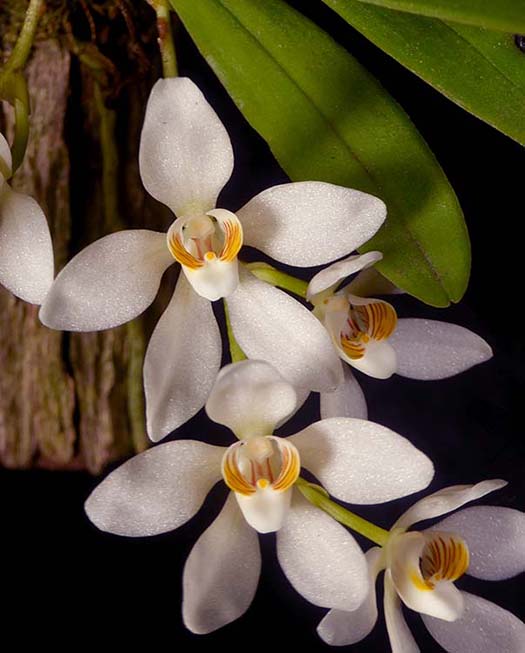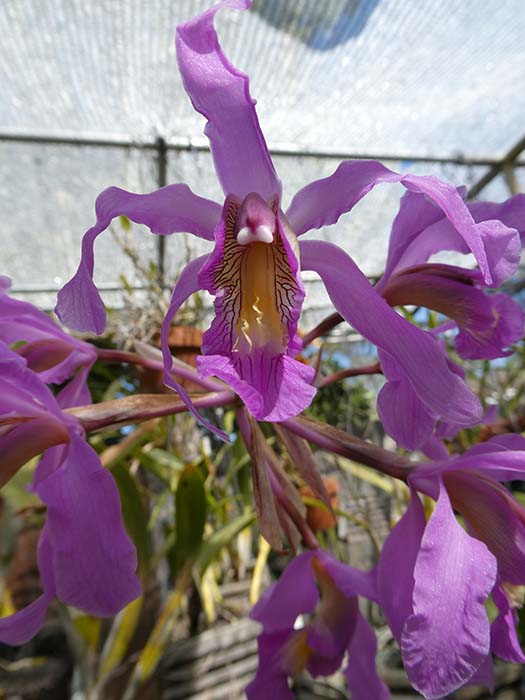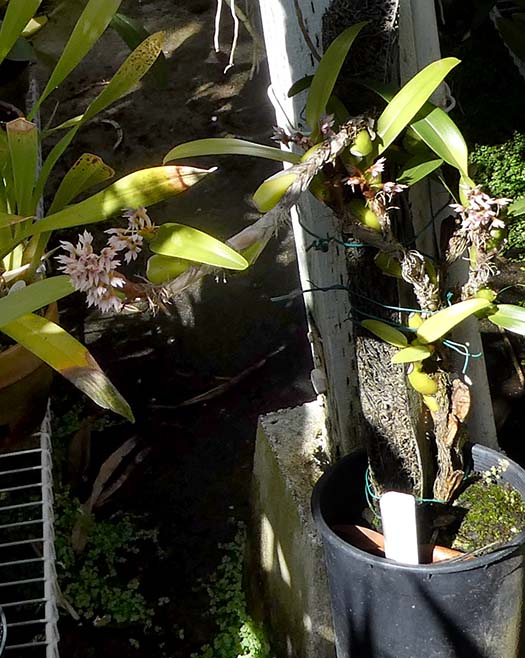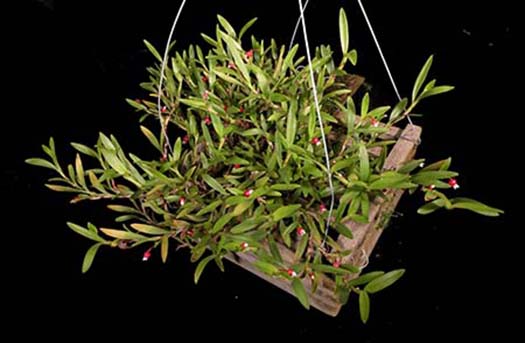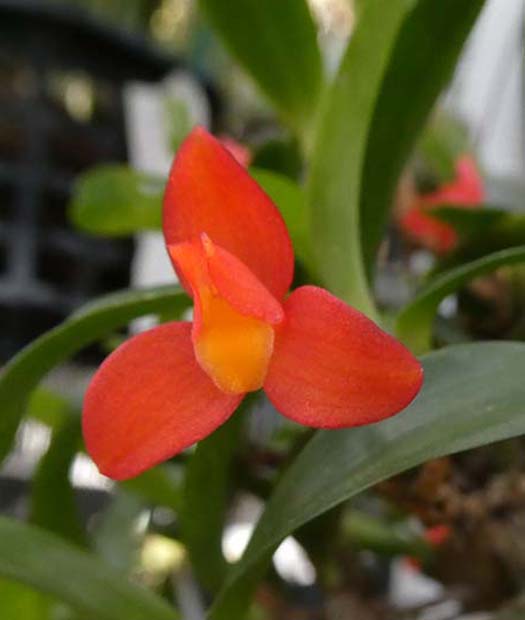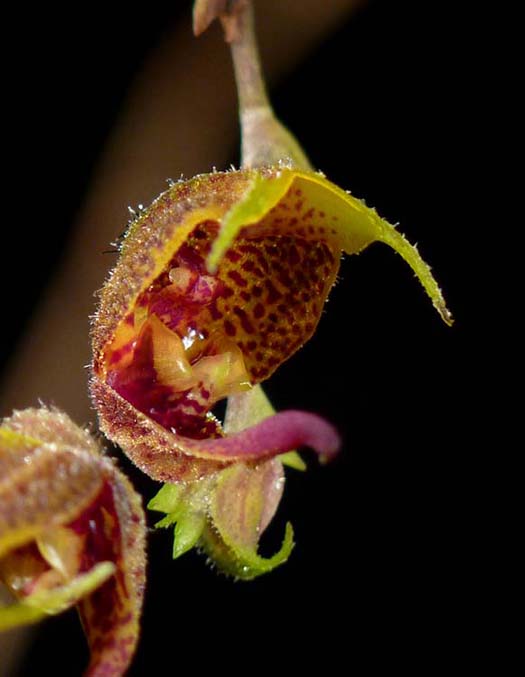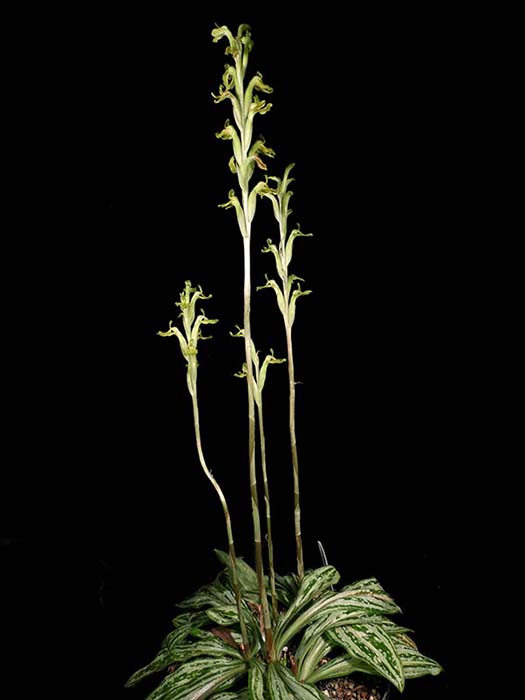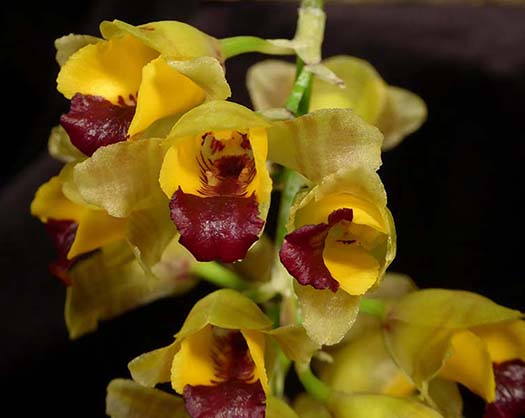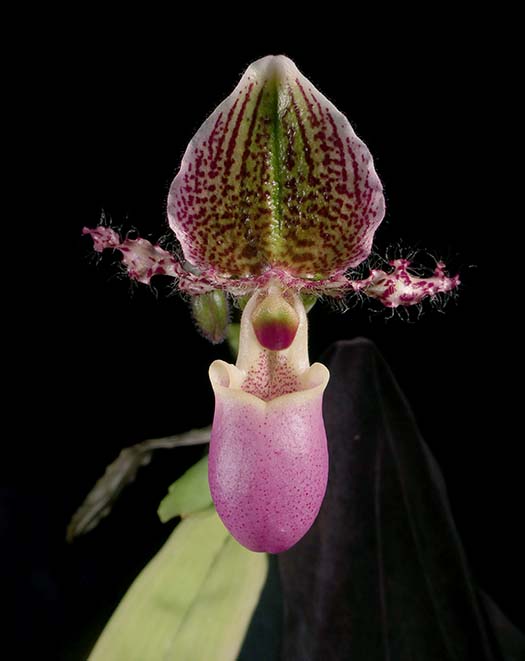April 2022
From Kurt Shanebeck:
|
|
Outdoors coastal, north of Los Angeles: |
|
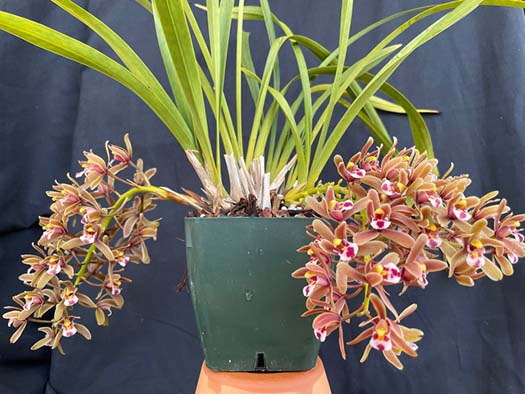
Cymbidium floribundumCymbidium floribundum one of the smaller cymbidiums from southern China— as the name suggests it produces a many flowered inflorescence. |
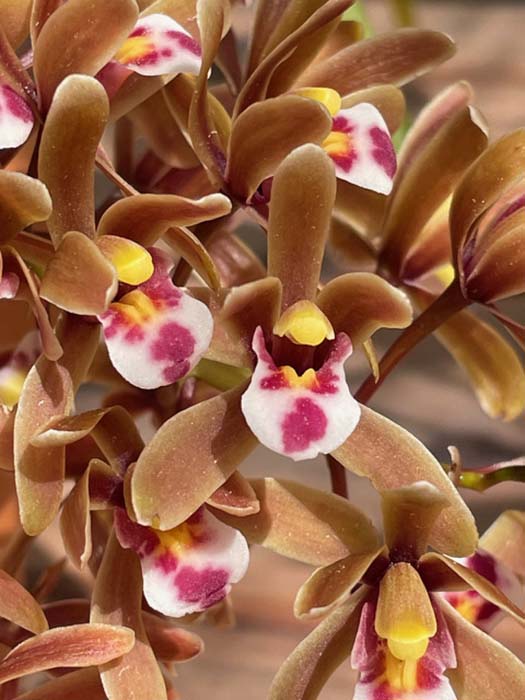 |
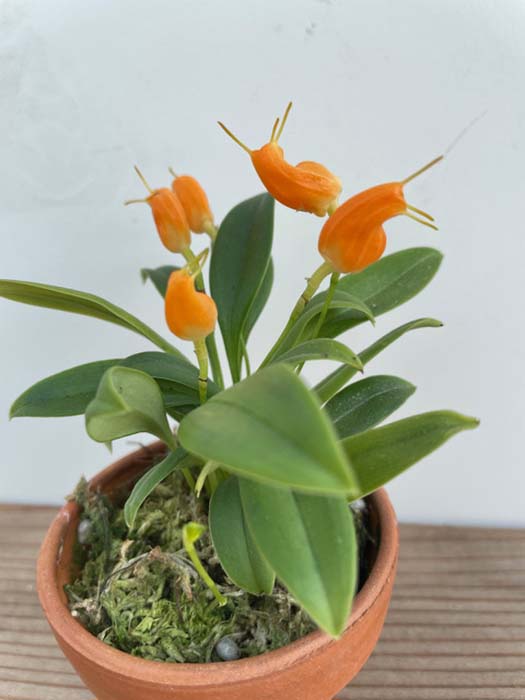
Masdevallia limaxMasdevallia limax—limax is latin for slug—its not hard to see where the name came from. Grows shady and moist. |
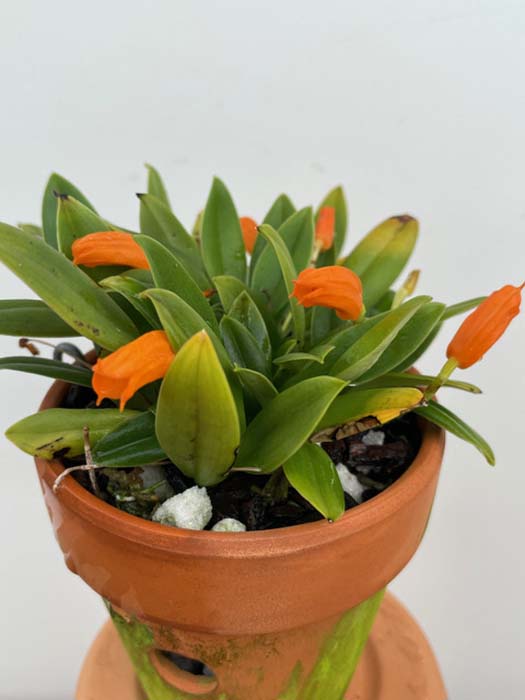
Masdevallia mendozaeMasdevallia mendozae—another similar Masdevallia with tubular flowers and similar growing requirements |
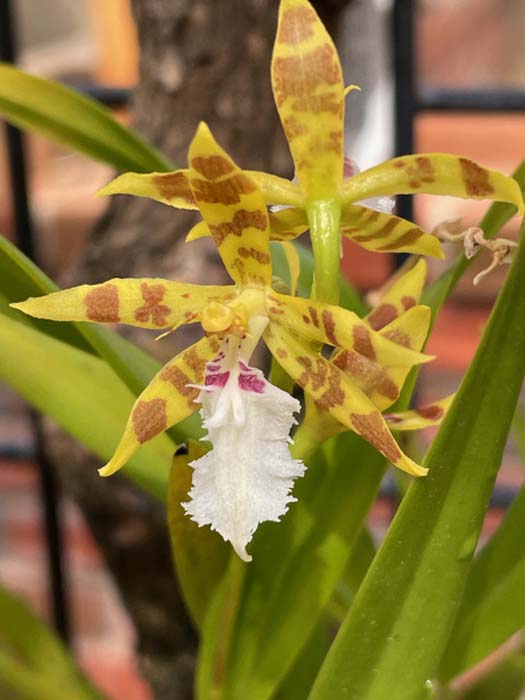
Oncidium aspidorhinumOncidium aspidorhinum. An orchid from the cloud forests of Columbia and Ecuador. It is growing mounted and gets daily water (reverse osmosis). |
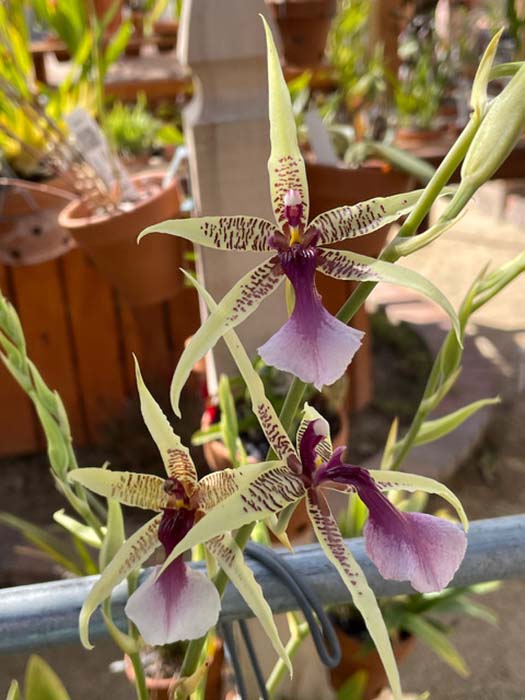
Oncidium hastilabiumOncidium hastilabium. One of my favorite Oncidiums. A robust plant with relatively large flowers. Grown potted in a bark mix with moderate light and water. |
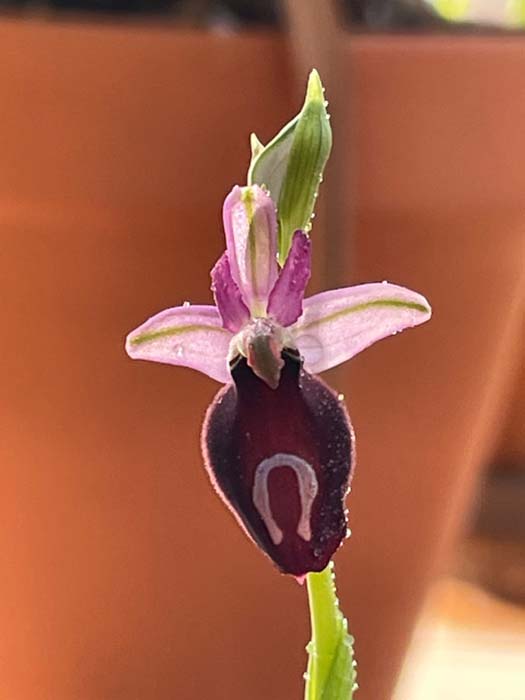
Ophrys ferrum-equinumOphrys ferrum-equinum. The name is latin for iron and horse—a reference to the horseshoe mark on the lip. Growing in pumice with a bit of coconut coir and some travertine chips (it was what I had on hand). This is my first attempt at growing Ophrys, so its long term viability is yet to be determined. |
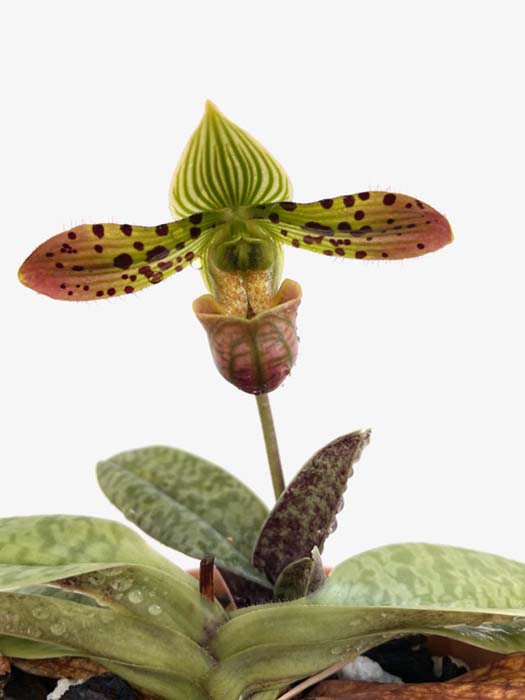
Paphiopedilum venustumPaphiopedilum venustum. I have often heard it said that Paphs with mottled foliage are warmer growing species, however this one seems to do reasonably well outdoors in coastal California. |
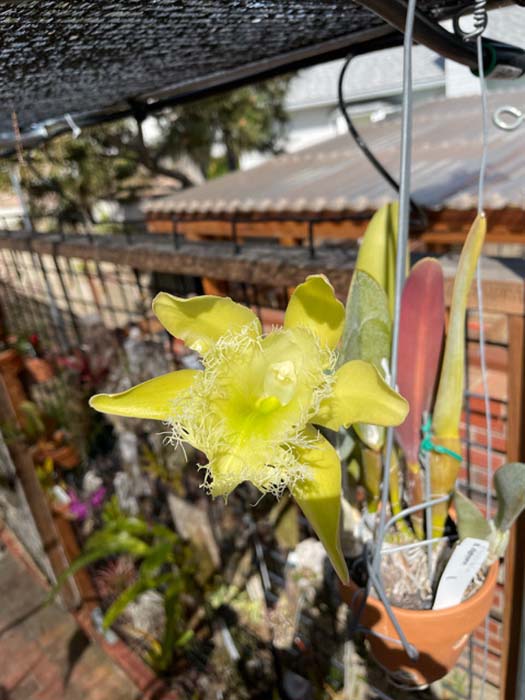
Rhyncholaelia digbyanaRhyncholaelia digbyana. From Mexico and Central America. Although generally thought of as a intermediate to warm grower, it seems to be quite temperature tolerant. I grow it where it gets full sun in the morning, then it is shaded by 50% shade cloth the remainder of the day.Large flowers with a frilly lip. |
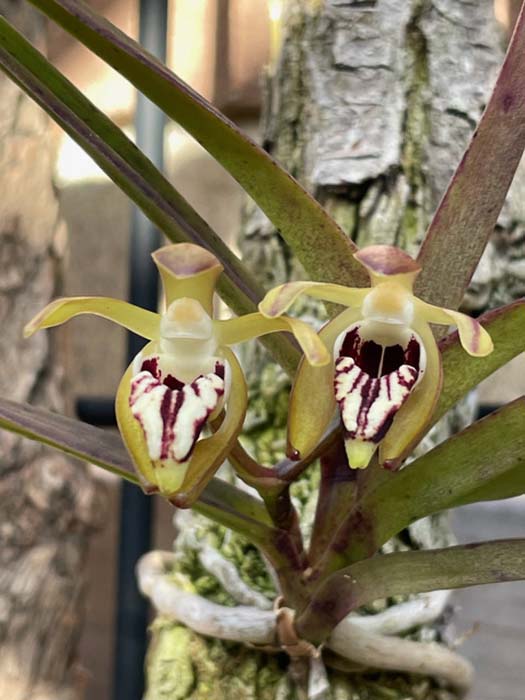
Vanda cristata (or Vanda alpina?)This is the first bloom of a Vanda I purchased from Andy Philips. It was labeled as Vanda cristata, however V. cristata should have ‘horns’ on the lip which are not present. A similar species V. alpina is almost identical except for the lack of horns on the lip, therefore I suspect that this is V. alpina. Both are cooler growing vandas from the Himalayas. |
Indoors, Under Lights: |
|
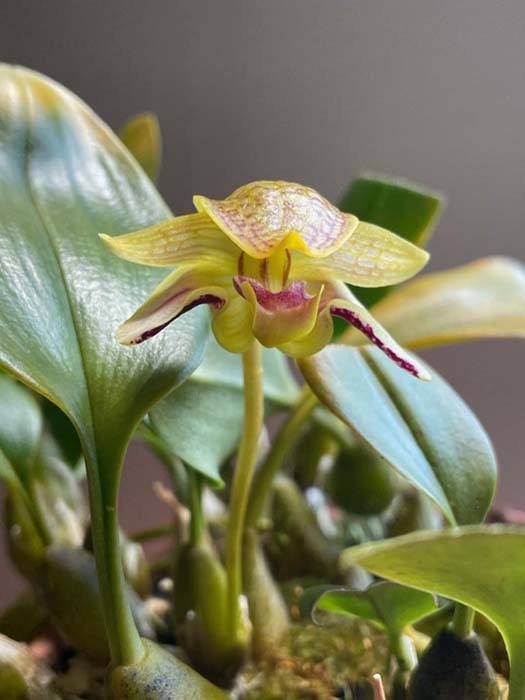 Bulbophyllum dearii |
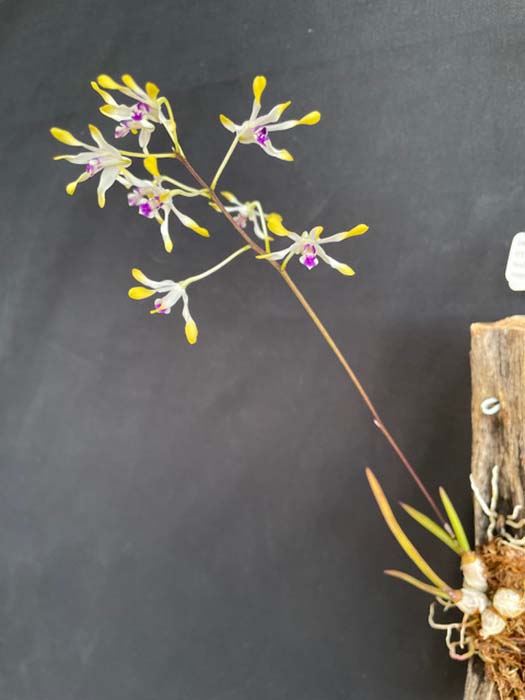 Dendrobium canaliculatum |
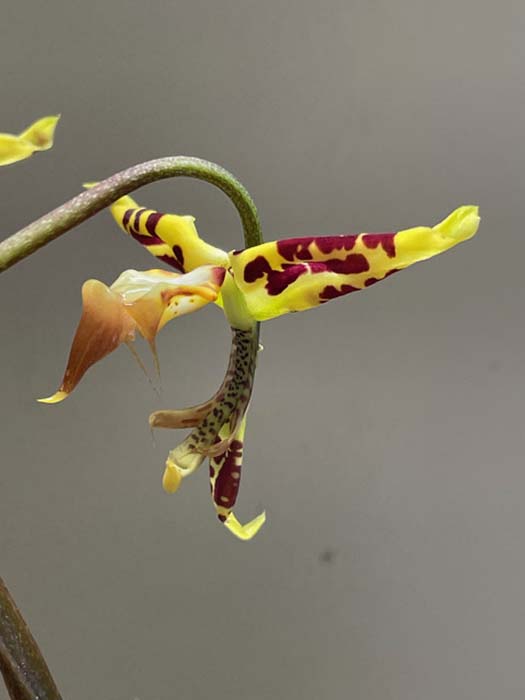 Gongora fulva |
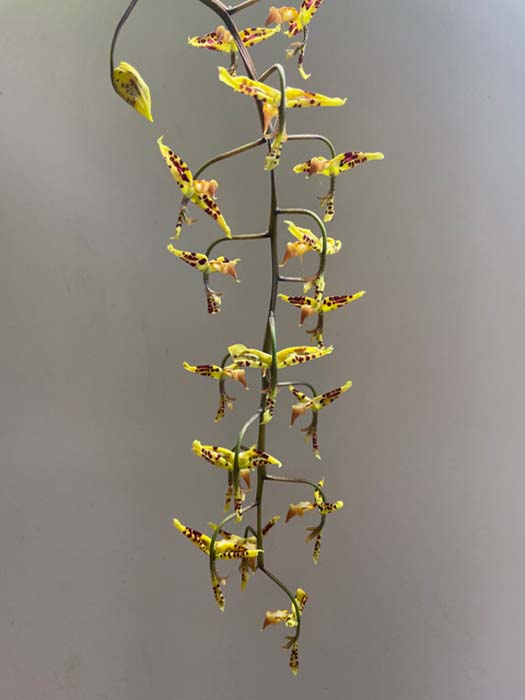 |
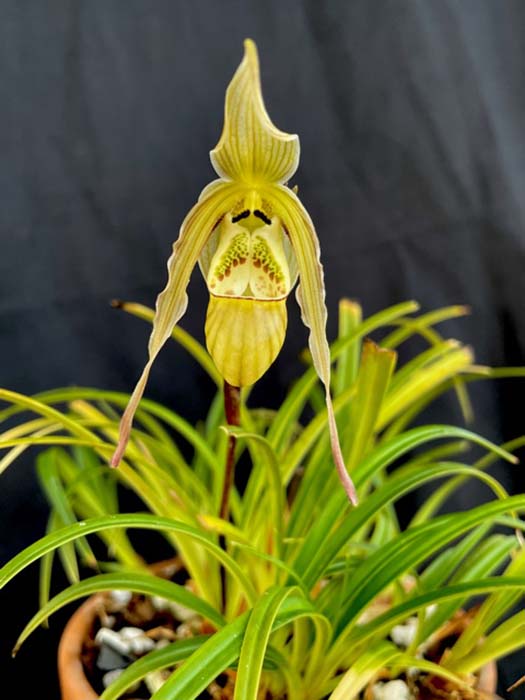 Phragmipedium pearcei |
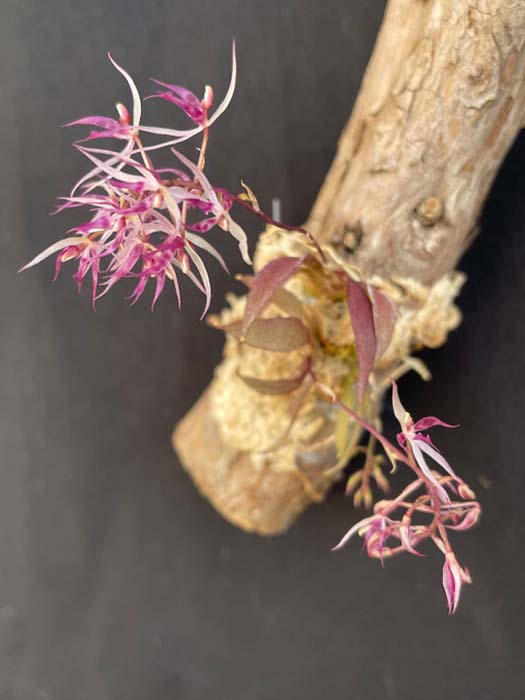 Macroclinium bicolor |
From Lynn Wiand:All orchids grown outdoors, coastal southern California |
|
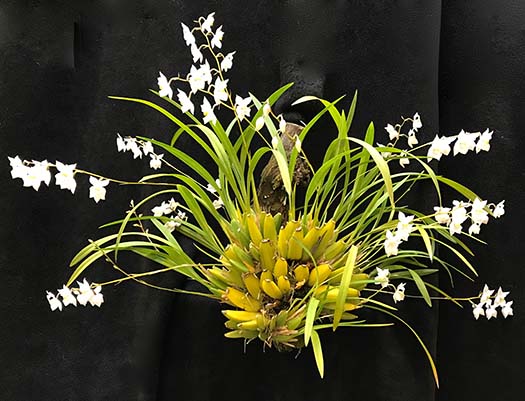 |
Oncidium pulchellumFrom Mexico. Spikes don’t open all at once for a lengthy bloom time. Very pleasant fragrance |
From Scott McGregor:All orchids grown outdoors, coastal southern California |
|
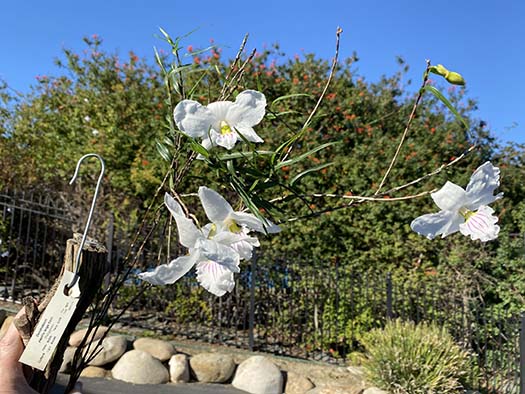
Dendrobium papilio (large form)Large 4” white flowers on the end of thin canes. Andy sells two forms of D. papilio—a “large form” that has sparse flowers, and a “floriferous form” with more abundant but smaller flowers. Happy to see my “large form” open four flowers at once plus an additional bud! These are hard to photograph as the flowers are on very thin, wiry canes that dart about in the slightest breeze.
|
|
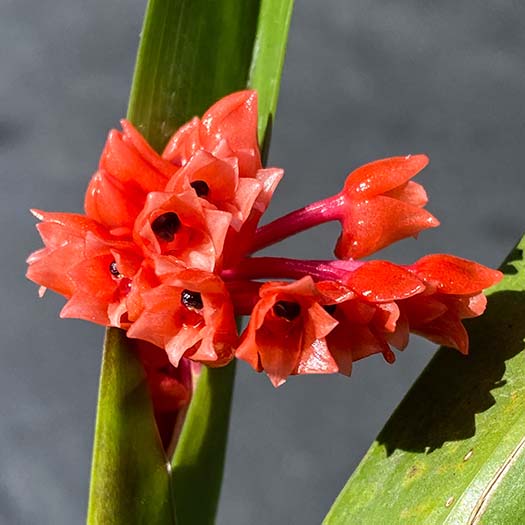
Epiblastus basilisAn odd, brightly-colored, cold-growing species from PNG that really wants to grow vertically, similarly to Maxillaria elatior. |
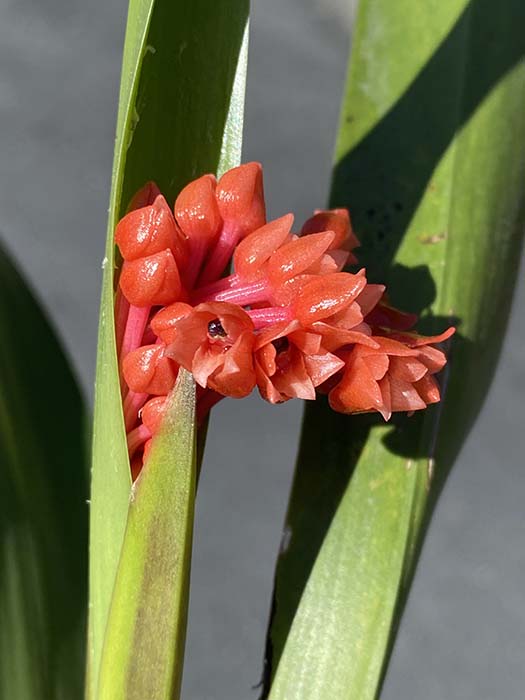 |
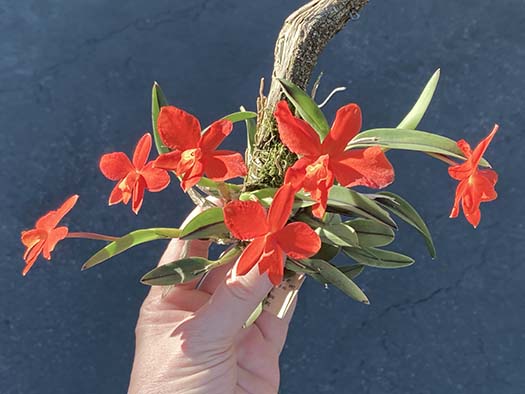
Cattleya (Sophronitis) mantiqueiraePretty red/orange flowers. Grows best mounted for me. |
|
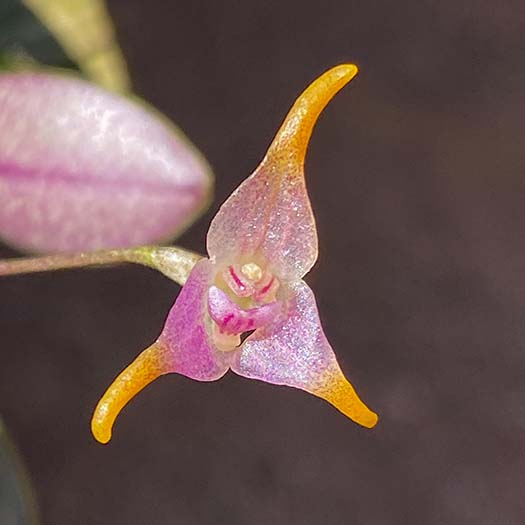 |
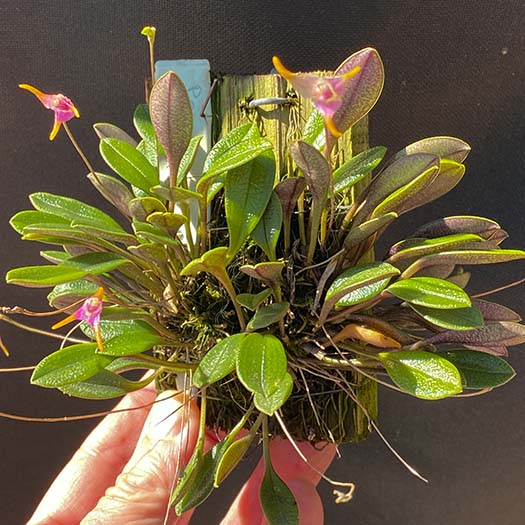 |
Porroglossum meridionaleA mini Pleurothallid that seems to always be in bloom with unusually-colored ½” flowers. I find this to be the easiest species in a genus that is rumored to be difficult to grow outside. |
|
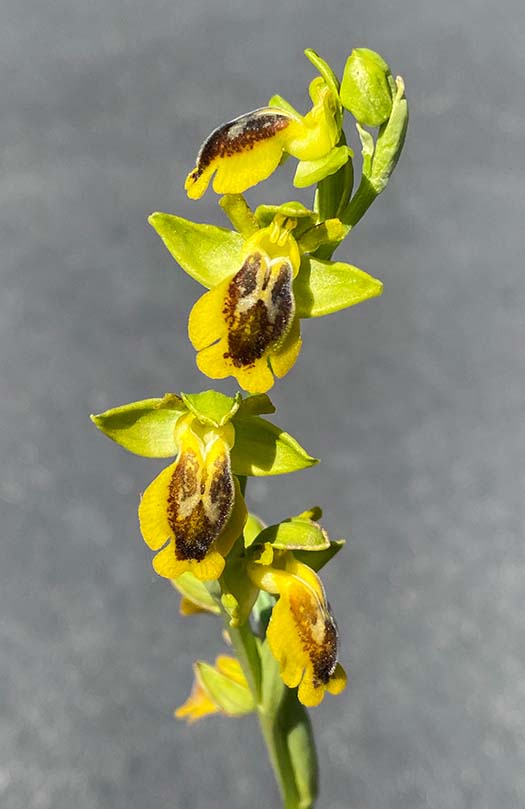
Ophrys luteaOphrys lutea at the peak of bloom, and the leaves beginning to die back for summer dormancy. |
|
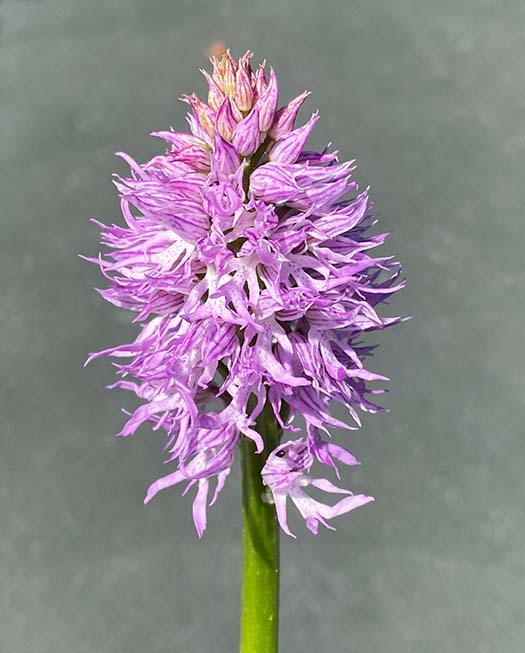 Orchis italicaThe “Italian Man Orchid” in full bloom from a large (30mm diameter) tuber. These are very fragrant during the day and smell like clover. Above, just starting to open and on the right, in full bloom. |
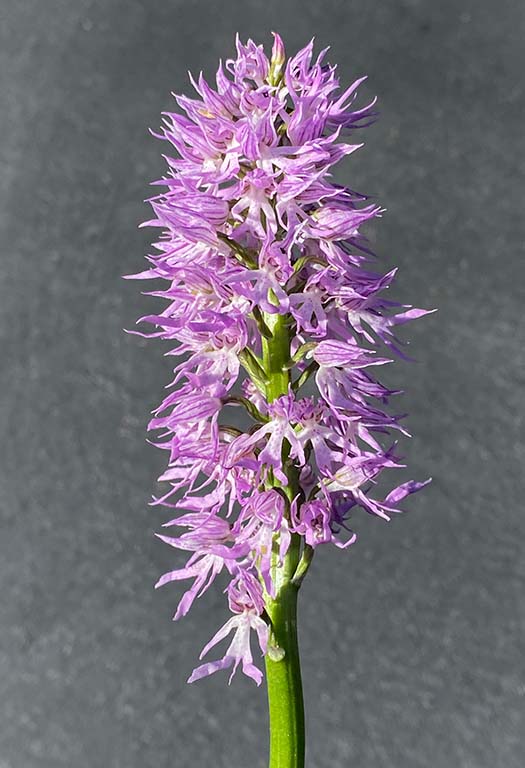 |
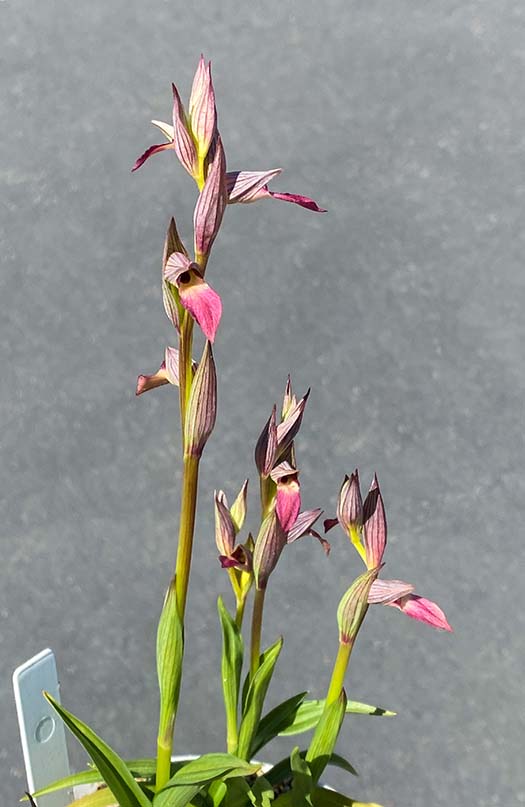
Serapias linguaThe easiest of the Mediterranean-climate species—this one grows into a small clump after a couple years and usually produces extra tubers to share. |

Osmoglossum pulchellumVery fragrant, white, long-lasting flowers—lasts from January through the end of March for me. I’ve had this plant for ten years, but it has taken a while to recover from its prior mount disintegrating. |
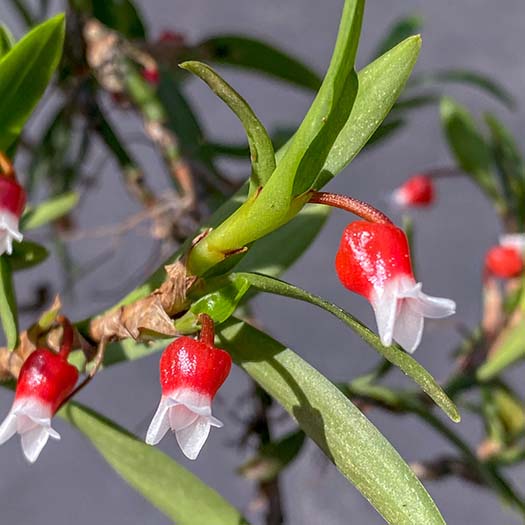
Mediocalcar versteegii (or not)That's what the tag says... but it sure looks the same as my Med. bifolium 'San Diego Zoo'. A lot of confusion between the two. See below for another opinion... My other Mediocalcar species were shy bloomers this year, but this M. versteegii (or likely Med. bifolium) came through. This species rambles and won’t stay in a pot, but has vivid red and white bell-shaped flowers scattered all over the plant.
|
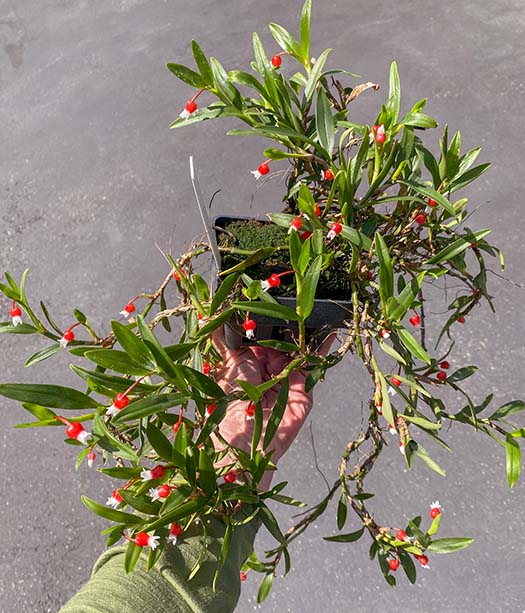 |
From Roberta Fox:
|
|
Outside in the Back Yard: |
|
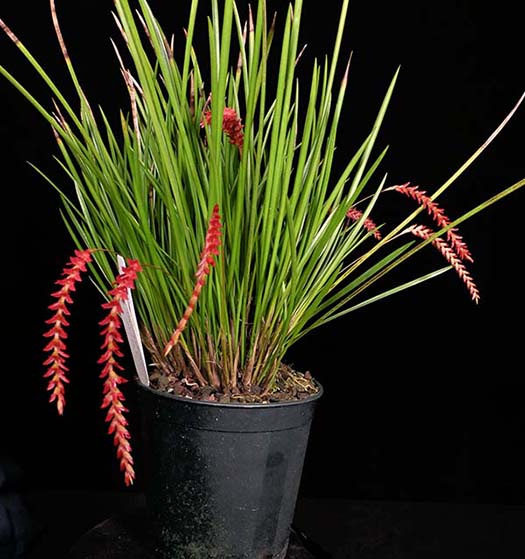
Dendrochilum wenzeliiNative to the Philippines, elevation 500-700 m, which would imply that it might need to grow warm/intermediate. However, it does fine on my patio. Maybe it would do better if warmer, but I'm not complaining! |
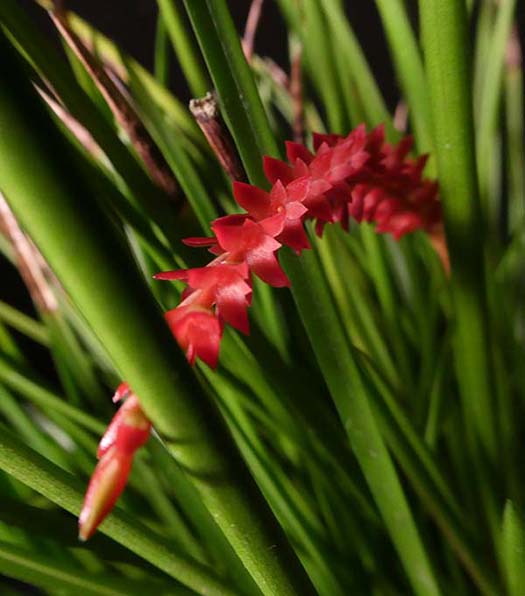 |
Dendrobium falcorostrumOne of the temperate-zone Australian Dendrobiums, in the same group as Den. speciosum. I don't dry it out in winter, but the chill seems to be what it needs to bloom nicely. The crystalline-white flowers are fragrant. |
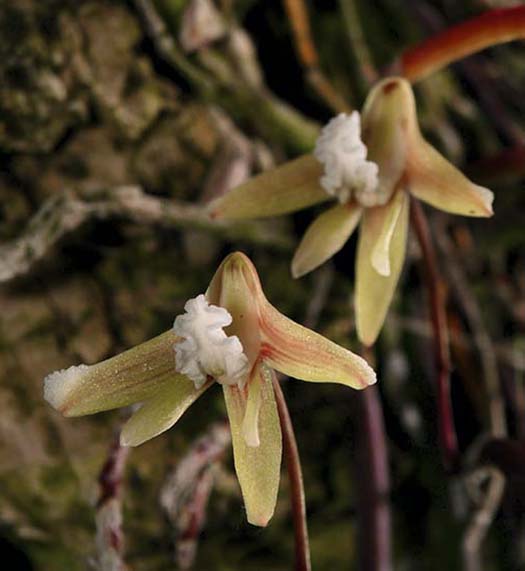
Dendrobium striolatumAnother Australian, with terete leaves. It has in the past been classified as Docrillia, but now back into Dendrobium. Mine isn't as floriferous as Lynn's but it is such a cute flower that I wanted to share it anyway. |
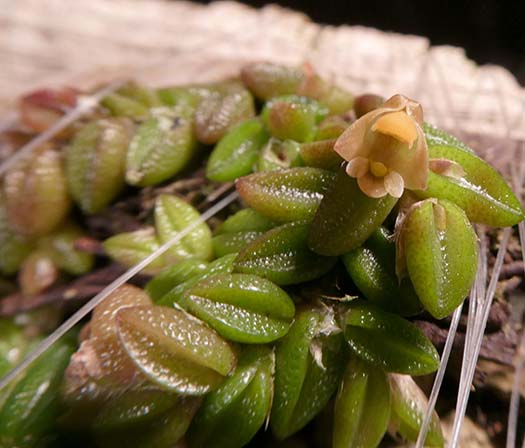
Dendrobium toressaeAnother one that was previously Dockrillia. This is a true miniature. Flowers are about 5 mm, the leaves about a centimeter. The leaves are very succulent, and the plant forms a mat. With high light, the leaves can be quite red. It is native to Queensland in northeastern Australia, at a range of elevations from sea level to about 900 m, so it tolerates a wide range of temperatures. |
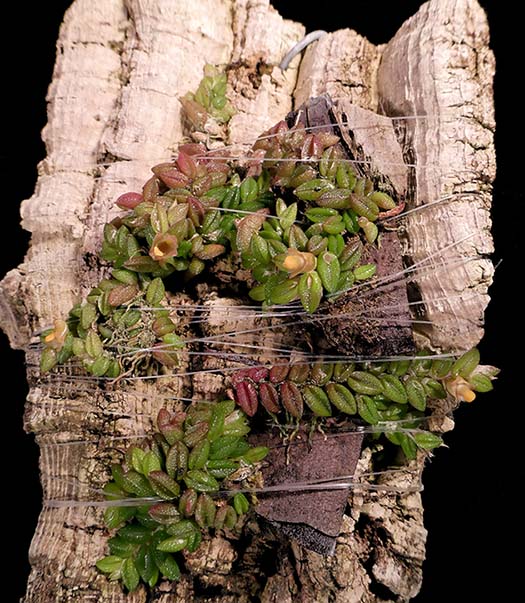 |
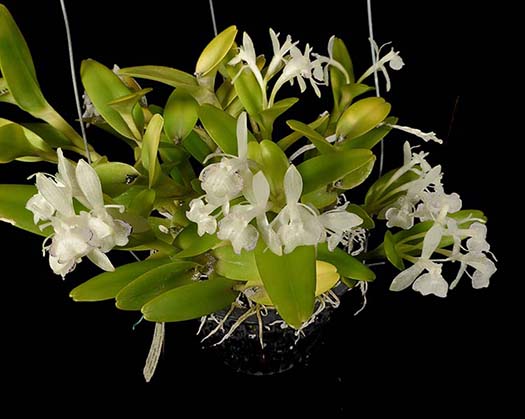
Epidendrum trialatumNative to Nicaragua and Oaxaca, Mexico at elevations of 1100 to 1800 m. It is in a 4 inch basket, roots totally entwined and extending beyond the basket. Flowrs about 3/4 inch, and very fragrant. It blooms reliably every year. A SBOE $7.50 special that has done very well for me for about 10 years.
|
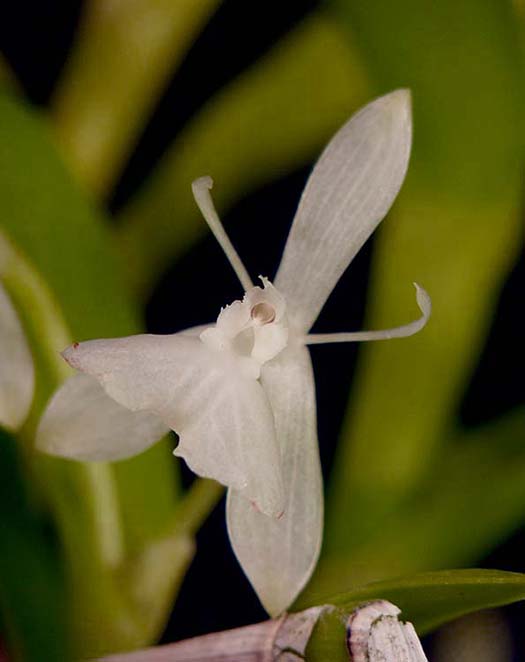 |
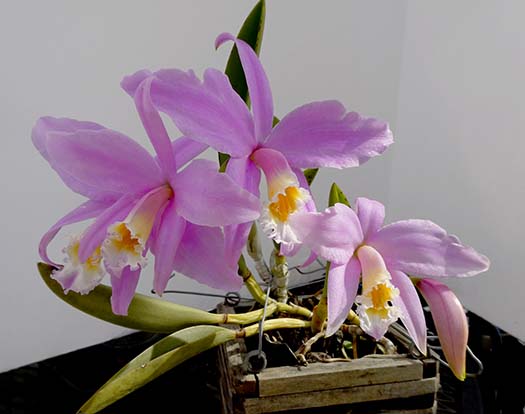
Cattleya (Laelia) jongheana 'Mango'This Brazilian species is very rare in nature, but is becoming more common in cultivation. This one has almost 6 inch flowers on growths that are about the same size. The flowers emerge from the newly-developing leaves, with no sheath. The "egg-yolk" color of the throat, with its very defined keels (ridges that guide the pollinator) is a dramatic contrast. Its roots hate to be confined, so it does best mounted or in a basket with large and well-drained bark, |
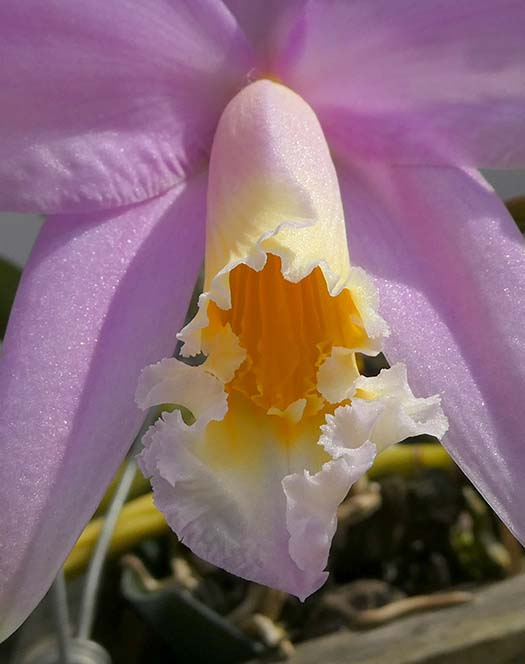 |
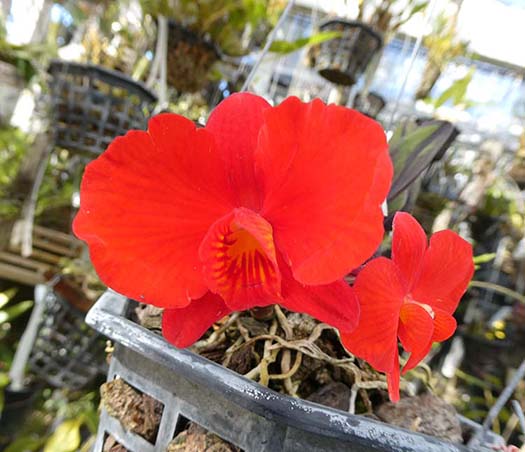
Cattleya (Sophronitis) coccinea 4nThe tetraploid genetics produce flowers that are very large for the species. The color is close to accurate - the intense red is difficult to capture. This is with natural light and not processed, I have found it nearly impossible to get it right with artificial light even with Photoshop. This plant blooms reliably every year, occasionally it will bloom twice. It is in a 6 inch basket with large bark. |
|
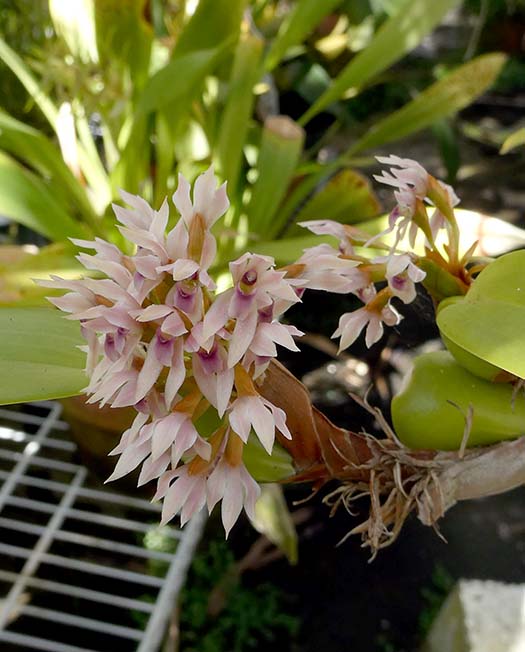 |
|
Maxillaria densaFlowers are about 1/2 inch, and there are LOTS of them - that makes up for the subtle color. The plant is a climber. I assume that there are some roots in the pot, but it mostly grows by producing new pseudobulbs on top of the older ones. Roots run through dry bracts between the growths. Eventually they fall off exposing roots and the plant seems to accommodate that, but it's easy to kill this type of Maxillaria by "tidy-ing up" by removing those sheaths. Let the plant manage those naturally. |
|
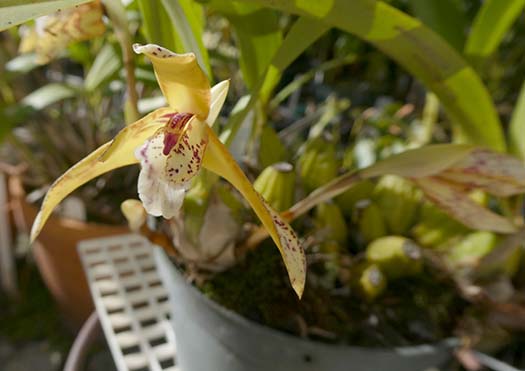
Maxillaria pictaThese grow very easily in southern California and lots of people have them. Buds are cream-colord with red spots, opening to show clear yellow on the inside of the sepals. |
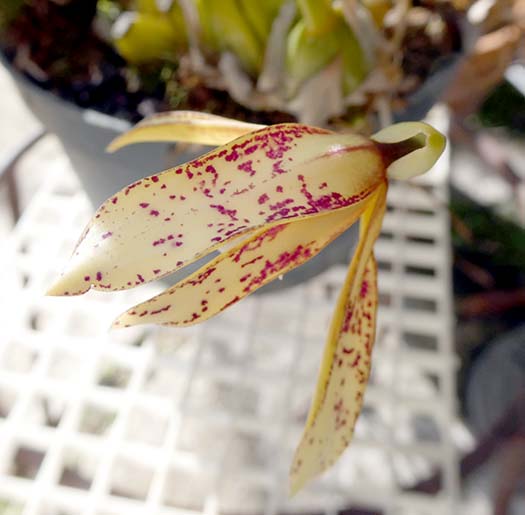 |
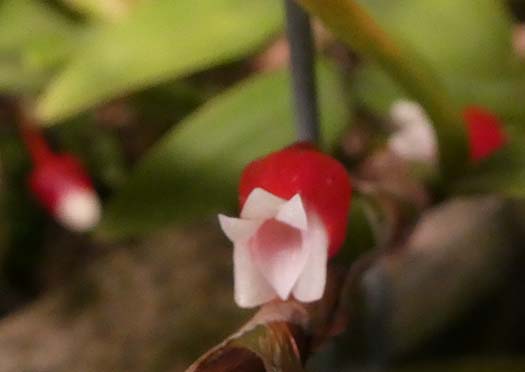 |
|
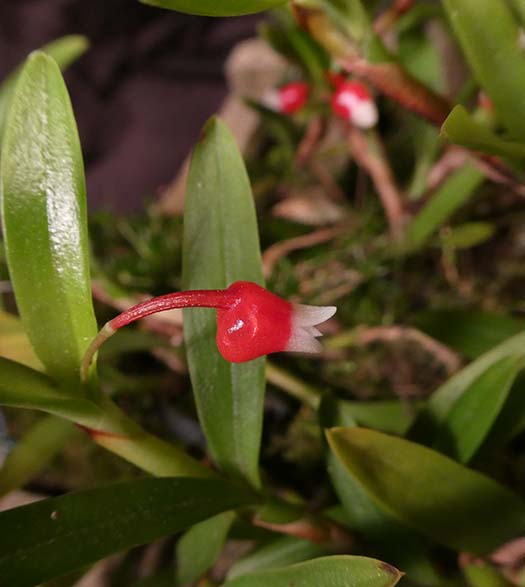 |
|
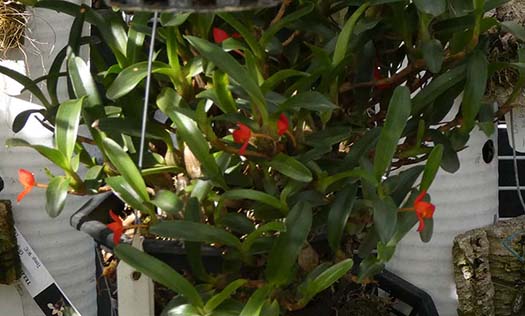
Maxillaria sophronitisYou saw Scott's last month, this month my turn. Flowers are small but brilliant. The plant pops out two or three flowers quite frequently, but a few times of year produces a flush bloom. I got it a 4 inch basket, a few years latter moved it to a 6 inch basket, which it has throughly outgrown. It's not getting a bigger one... the free-hanging roots seem to get sufficient water to continue to grow profusely in the shady spot where I hang it. |
|
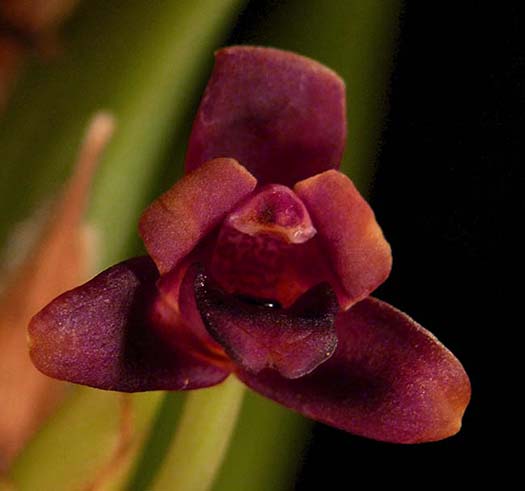 Maxillaria variabilisAnother Maxillaria with small but but profuse flowers. Plants are in 4 inch baskets. The species lives up to its name. I have another that is dark bugundy, amost black, and another that is dark red with distinct gold tips on the sepals. |
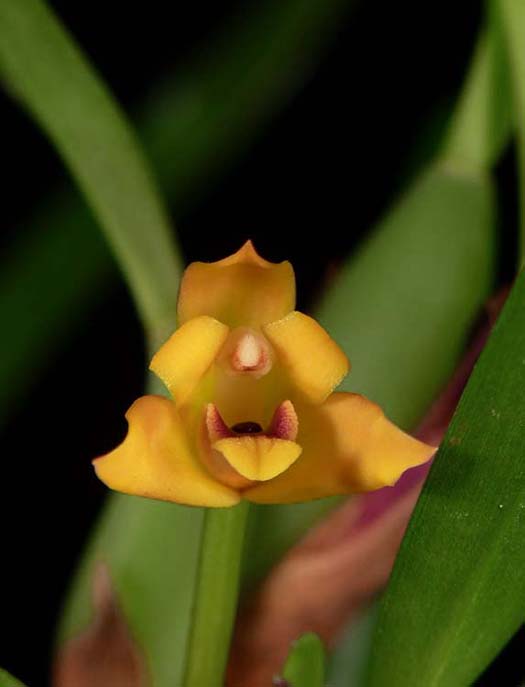 |
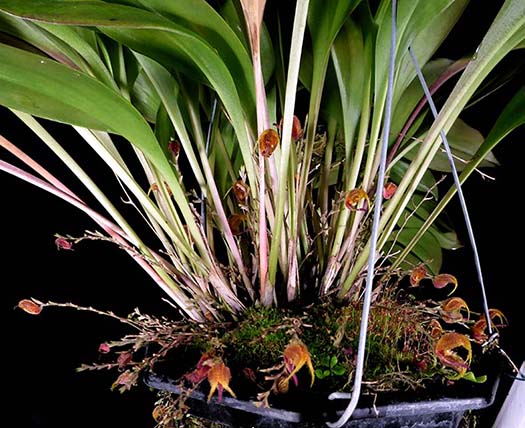 Scaphosepalum beluosumThe flowers of this genus are mostly quite small - these are about3/8 inch. But close up, they are very complex and dramatic. They bloom sequentialy on the inflorescences, |
|
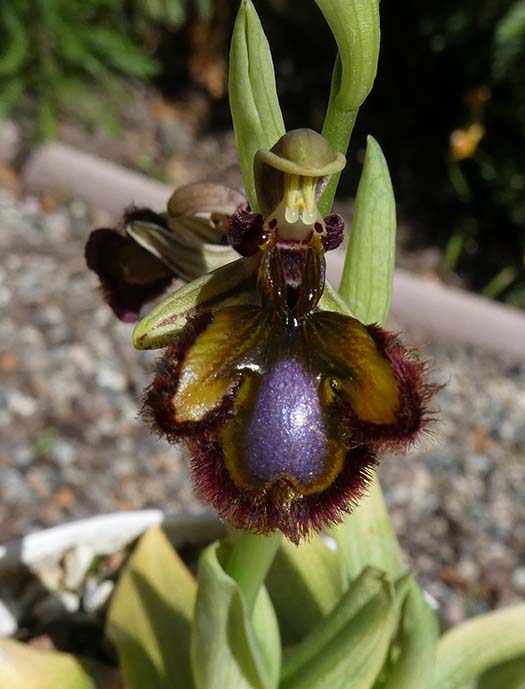
Ophrys speculumGetting close to the end of the Mediterranean terrestrials, but some of the best for (almost) last. Ophrys speculum is such a perfect little bee. I think my favorite of the group. |
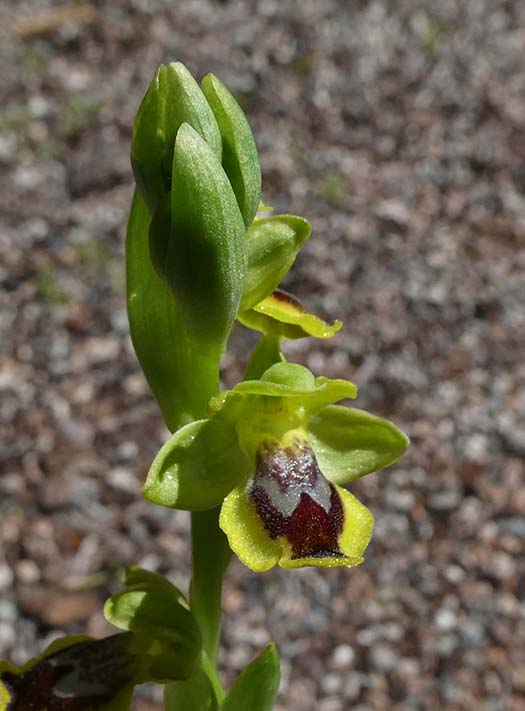
Ophrys luteaOne of the most vigorous of my Ophrys. Full of contrasts - brilliant yellow, fuzzy brown, and a combination of fuzzy and shiny blue-gray. |
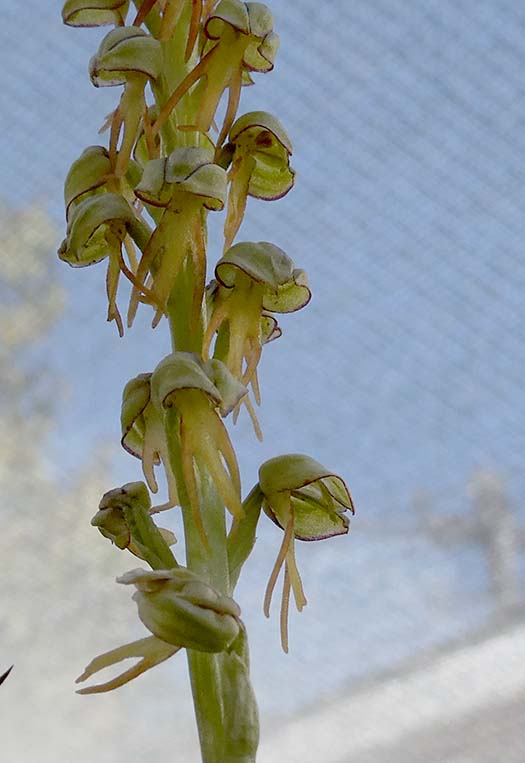 |
.jpg) |
Orchis anthropophoraSort of a "little man". Here in natural light, and a "studio shot". Time for some more genera of the Mediterranean terrestrials. |
|
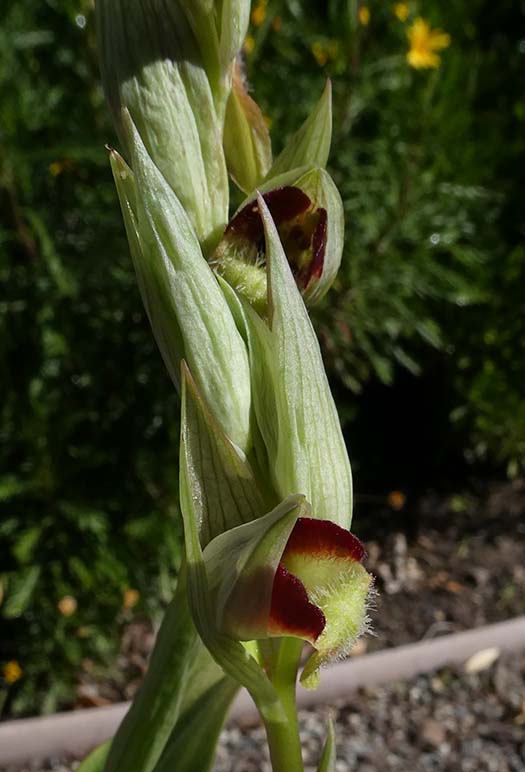 |
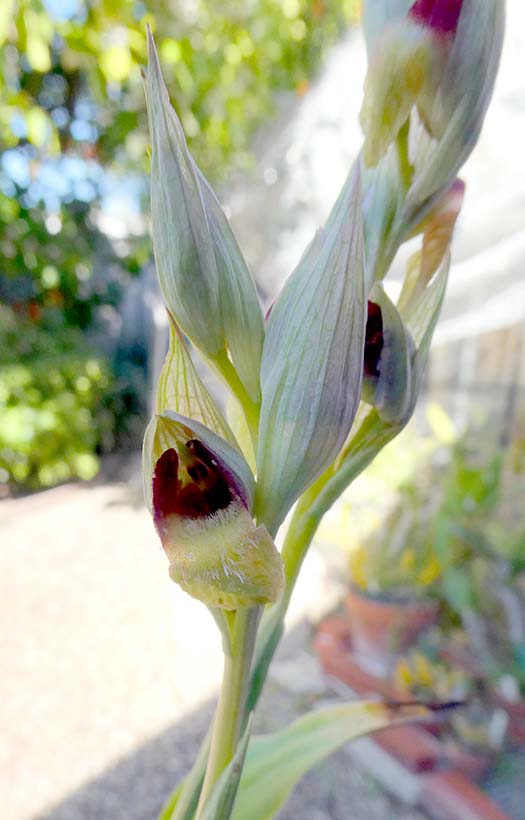 |
Serapias bergoniiOne of the larger members of the genus |
|
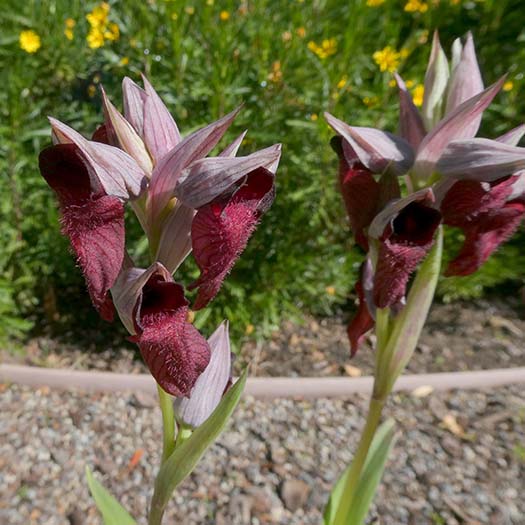
Serapias cordigeraAnother relatively large flowered species. Note that the leaves are already showing signs of dormancy. Once the flowers are done, it'll be time to stop watering, |
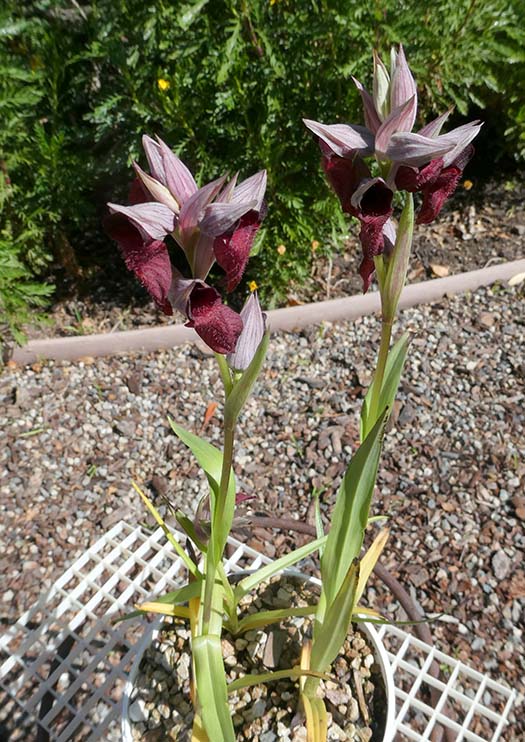 |
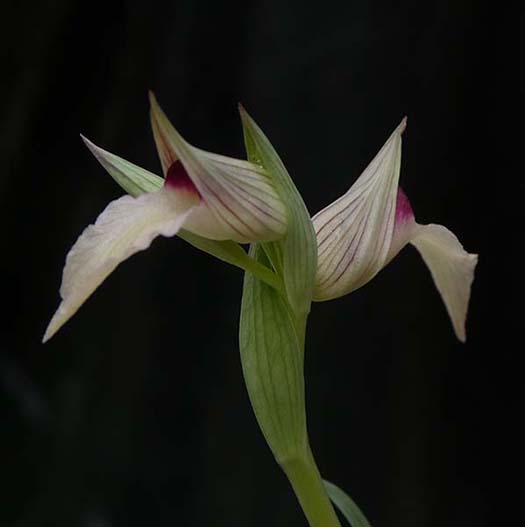
Serapias linguaThere is a lot of color variation in this species, from pale beige through light pink to dark red. |
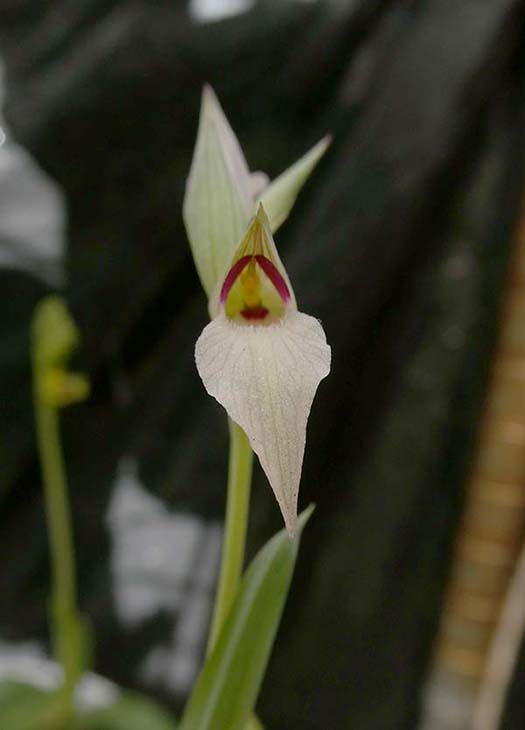 |
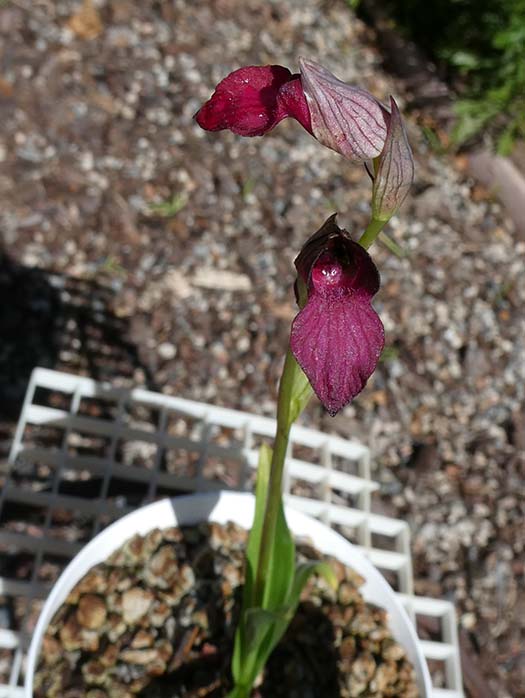
Serapias linguaAnother plant. Along with dark color, the lip is a little broader than the one above. There are a few closely related species, and confused taxonomy, so maybe they are the same species and maybe not. |
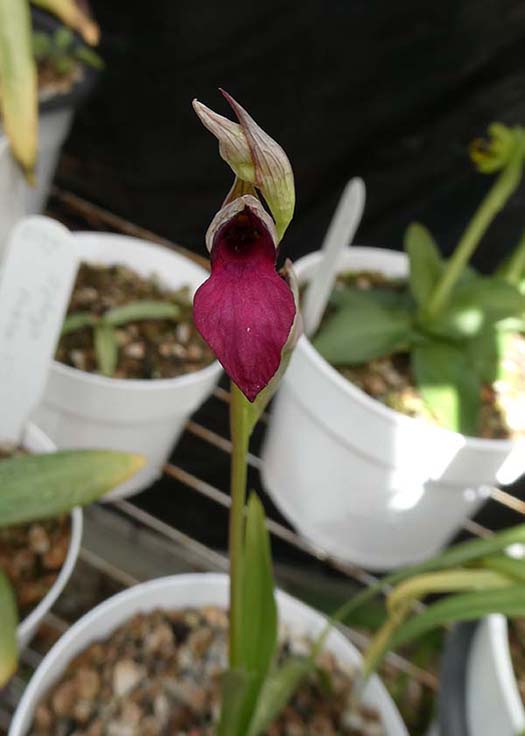 |
In the greenhouse... |
|
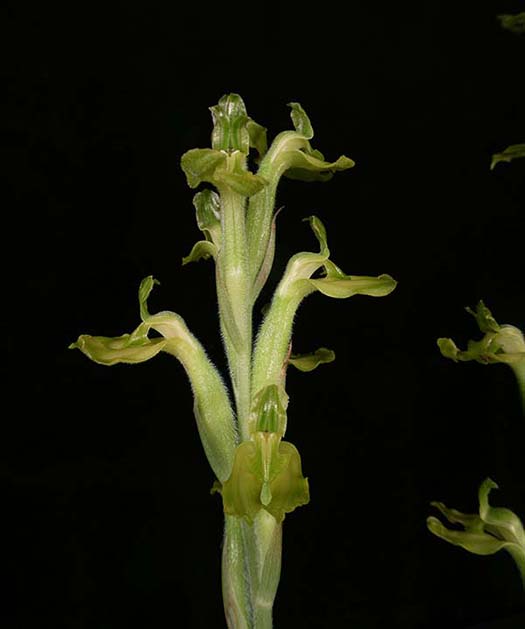
Sarcoglottis sceptrodesA "painted leaf" orchid. This one needs warmth, but not a lot of light. Therefore, it would grow nicely as a houseplant. It is attractive even when not in bloom. The weird flowers remind me of a seahorse, or a dragon. |
|
